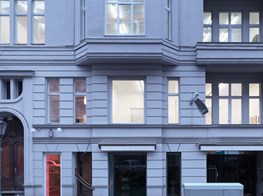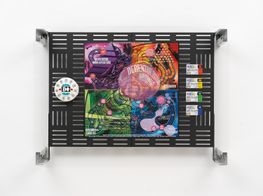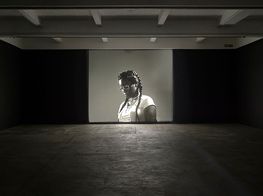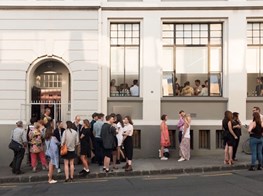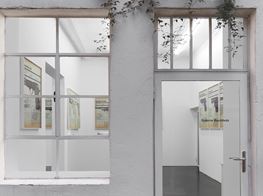Anna-Marie White
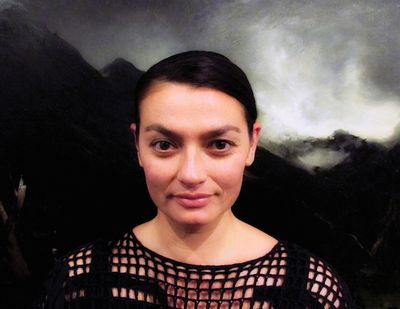
Anna-Marie White is Curator at The Suter Art Gallery Te Aratoi o Whakatū in Nelson, New Zealand and most recently a member of the jury that selected this year’s Walters Prize nominees: Simon Denny
, Maddie Leach, Luke Willis Thompson and Kalisolaite ‘Uhila. Named in honour of the New Zealand modernist painter Gordon Walters and hosted bi-annually by the Auckland Art Gallery, the prize throws a critical spotlight on influential contemporary practices in New Zealand. Like Britain’s Turner Prize, the Walters courts a media-savvy mix of art-world prestige and cultural controversy. Anyone interested in the latter will not be disappointed with this year’s finalists whose works have put pressure on traditional expectations of viewing art.
This year’s Walters Prize exhibition is notably lacking in things to see, but it does offer quite a lot to do. Simon Denny’s extensive display of tech-industry related info-panels is the only work that has been explicitly installed in the exhibition spaces, while the other three expand in intriguingly different directions both in and outside the gallery. Luke Willis Thompson’s work involves the prospective viewer taking a taxi ride to an undisclosed residential location. Maddie Leach’s elusively poetic work is dispersed across different platforms, alighting on narratives relating to the politics of oil drilling in the Taranaki region in the west of the North Island on New Zealand. And Kalisolaite Uhila’s performance work has the artist living rough in the gallery vicinity for the entire 3-month period of the exhibition.
Each of these works requires a commitment from audiences that is not immediately evident. You might have to plan a trip; you might have to decide how to engage, what to do, or how to behave; you won’t always know what is happening; your values will be challenged; you will have to read, and read again. Given that there is no obvious visual spectacle on which to rest one’s eyes, this experience can be somewhat exhausting. The most cynical will dismiss it as an example of contemporary art’s fundamental inaccessibility. Others, like this writer, will celebrate it as evidence of art’s interest in the potential of immateriality, or more specifically, in performance, ‘relational’ activities and social systems that expand in time.
Already two months into its exhibition run and just before the prize itself is awarded by the international judge Charles Esche, Ocula caught up with jury member Anna-Marie White to discuss what has been billed as New Zealand’s “toughest” art prize.
Before discussing some of the more meaty issues at stake here, I want to ask you about why the Walters Prize is important and what sort of criteria the jury used to select the nominees.
The cynic says the Walters is important because it says so. But from a more considerate perspective, the prize is hosted by the Auckland Art Gallery which remains New Zealand’s leading art gallery, and this is its commitment to contemporary art. The jury were concerned about the different ways in which art works could be said to make a significant contribution to contemporary art in New Zealand, and we determined this, in large part, on a measure of influence. Which works made a difference? What rippled, what maintained a potency and momentum over time? In this sense, we weren’t influenced by any specific directive. We had to pull back the impulse to curate the exhibition, trying really hard instead to judge the merit of an individual work, which of course, cannot be entirely removed from the context of that artist’s broader practice.
Can you talk about the lack of a significant visual presence in the gallery spaces—a material absence that has irked more traditionally-orientated audiences. Simon Denny’s work is the only one that has an explicit material presence.* His work All You Need Is Data is a series of info-panels whose skeuomorph graphics, images and quotes ‘document’ the influential tech-conference Digital Life Design that was held in Berlin in 2013.
Simon Denny’s work operates in an interesting context. He is described as a post-internet artist and is concerned with intangible systems of knowledge. While his work offers a tangible realisation of these internet-based knowledge systems, you’ve got the other nominated works which are effectively dematerialised. I thought that putting his work in this context this was an effective way of both recognising his achievements and holding them to account.
Denny’s info-panels are mounted on a series of industrial-looking barriers arranged to guide the viewers through the exhibition space. Luke Willis Thompson’s work is similarly prescribed or pre-determined in that it involves taking a pre-paid taxi ride to an undisclosed residential location in Auckland. The gallery has kept the lid on the details of this work in order to maintain the integrity of the journey. But we can say here that the visit to this house confronts cultural mores and expectations of identity, privacy and domesticity. What is your take on this work?
This is a potent art work that intimately addresses issues related to biography, identity, class and society. Regardless of whether or not you have information about the location before hand or can experience the art work as a mystery, having to place your trust in the unknown is really important. This encounter with the known and unknown makes this a rich work that moves ground in terms of art’s history.
More than other years, this group of Walters Prize nominees seem to be concerned with socio-political issues and how society is structured. Whether it is the knowledge systems and economics of the internet or issues of poverty and inequality. Was this something you were interested in or aware of as a jury member?
What we’ve seen in contemporary art, for the last decade at least, has been works that exist in a kind of stasis. Those works refused any kind of specific reading so much as they offer a labyrinth of ideas. But what the Walters jury found were a group of artists that were daring to say something: their works had specific content and they actually held a political position. Within the terrain that we’ve been working in, I believe that this is a new direction and corresponds with the priority the Walters Prize puts on artistic innovation.Kalisolaite ‘Uhila’s work has been covered in the media and has received a great deal of general chatter, discussion and criticism. ‘Uhila has become part of Auckland’s homeless community at a time when social and economic inequality is increasing in New Zealand and Pasifika people are appearing on the wrong side of this widening gap between rich and poor. His work has been confronting for many people…
Yes, ‘Uhila’s work has been the subject of a lot of analysis and criticism. I think it’s really good that he’s been given this attention: people are talking about it, thinking about it and debating it. That’s the whole point of the Walters Prize—it aims to encourage dialogue and debate. I can see that happening with this year’s Prize, more so than in the past and I’m really enthusiastic about that.
There has been a lot of speculation about this work and the perceived notions of authenticity that accompany it. Many people seem to believe that in order to have any integrity this work needs to mimic the conditions of homelessness as much as possible. That’s an interesting but limiting reading. ‘Uhila talks about this art work in terms of relationships. It is about forcing a relationship with certain groups of people and the gallery as an institution. He is not homeless; he is effectively living at the gallery and requiring the gallery to determine the conditions of his living. This is a distillation of broad and complex issues about the relationship and responsibility of individuals to the state and vice versa.
Maddie Leach’s work is dispersed over many different platforms that revolve largely around interactions with the Taranaki Daily News. The work is elusive in the way that it can’t be tied to any particular message, activity, broadcast or representation. This gives it a poetic and ‘mythic’ quality—how do you respond to this work?
Maddie Leach’s work is the most reserved, but hit a nerve in Taranaki where there are deep divisions regarding the impact of oil drilling. Oil is a lucrative and high-risk business and has picked up the local economy after the freezing works and the petrochemical boom left of. Despite this, there is strong resistance to the recent growth in onshore drilling where the environmental impacts are plain to see. In many ways, Leach gave voice and focus to widespread community unease. Her two year project included a text banner on the upper façade of the Govett Brewster Art Gallery, which said “if you find the good oil, let us know” and could be seen from points around town. While this may have been read as a poetic statement about oil drilling, it could also be regarded as a call to the people working on the rigs – off and on shore; an ironic statement that reflects how the city’s livelihood depends on striking oil but at the same time, the citizens are not the primary beneficiaries of this natural resource. I thought this was a wonderfully purposeful work that captured, in a suitably ephemeral way, the tail end of the capitalist process. —[O]
*Interestingly enough, ’Uhila’s work has gradually garnered some material presence in the gallery where the artist has invited visitors to write and draw on an exhibition wall near where he has been known to take a nap during the day. ‘Uhila also continues to accumulate objects that aid his living outdoors. Objects such as a bike, shopping trolley, stacks of cardboard or blankets can be seen scattered around the gallery’s exhibition spaces. These things could be considered ‘ready-mades’ that have not been stripped of their functionalism.

